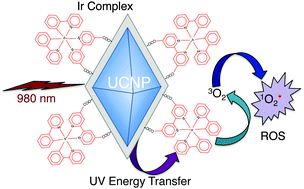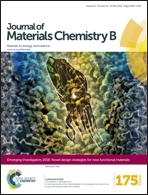Near-infrared triggered generation of reactive oxygen species from upconverting nanoparticles decorated with an organoiridium complex†
Abstract
Recently, research efforts have been focused on developing near-infrared perturbable nanoparticles to sensitize photostimulable molecules for the production of reactive oxygen species. Research in this direction is looking to broaden the use of photodynamic therapy, an indispensable clinical tool for cancer therapeutics, which relies on the photoexcitation of a suitable photosensitizer, to convert light into reactive oxygen species that are toxic to cells. To date most commercially available photosensitizers are excited with high energy light (UV or visible) presenting disadvantages that limit the clinical use of this technique to cancers that are on or near the surface of the skin. Here, we develop a hybrid platform capable of near-infrared triggered generation of reactive oxygen species. This hybrid nanostructure is based on LiYF4:Tm3+,Yb3+ nanoparticles, which are capable of producing strong UV emissions, following excitation at 980 nm, through a multiphoton process known as upconversion. When appropriately surface functionalized with an organoiridium complex, excitation at 980 nm produces a strong UV emission, which is absorbed by the organoiridium molecules on the surface, in turn generating reactive oxygen species. Moreover, the effect of the organoiridium concentration on the surface of the upconverting nanoparticles as well as the nature of the sensitization process is discussed.

- This article is part of the themed collection: Emerging Investigators 2016: Novel design strategies for new functional materials

 Please wait while we load your content...
Please wait while we load your content...